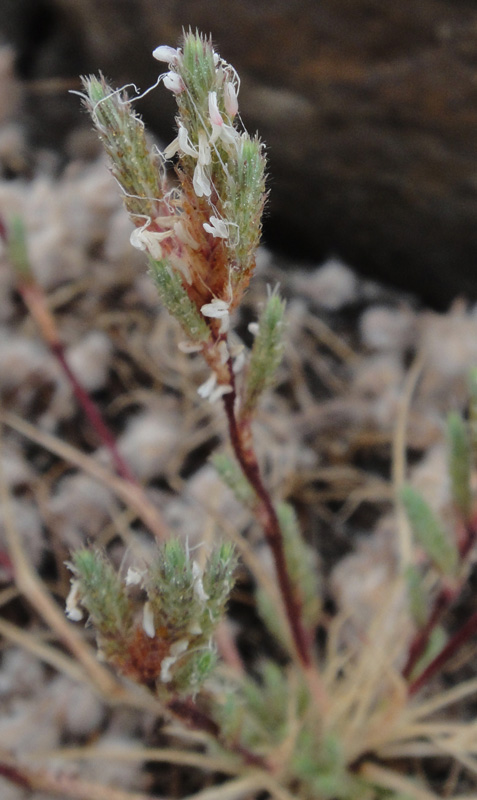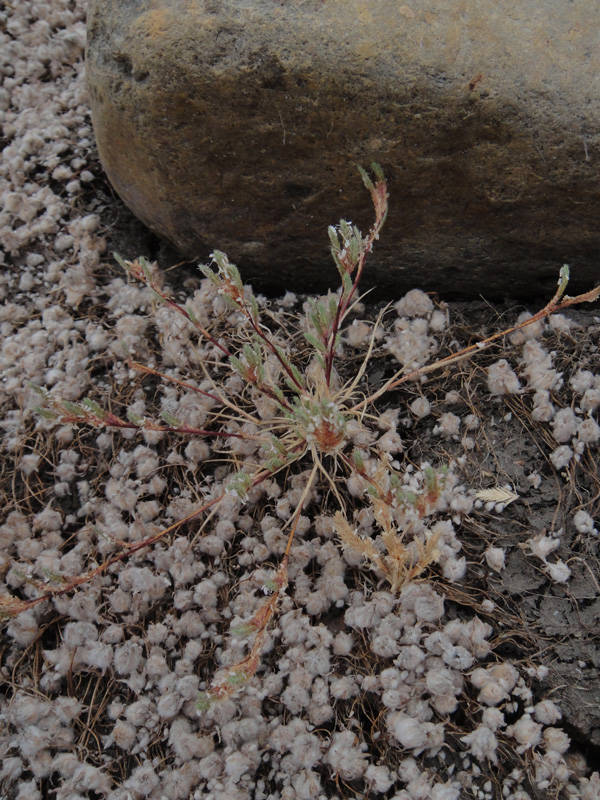
California Orcutt Grass
Orcuttia californica
Orcuttia californica
Photo Credit: Anna Bennett

California Orcutt Grass
Orcuttia californica
Orcuttia californica
Photo Credit: Anna Bennett
Goal: Protect, enhance, and restore California Orcutt grass occupied and historically occupied habitat to create self-sustaining populations that are resilient to environmental stochasticity and threats, such as altered hydrology, climate change and invasive plants, and will be likely to persist over the long-term (>100 years).
Management units: 3
Beginning in 2018, conduct annual surveys for California Orcutt grass in occupied, historically occupied and potentially suitable vernal pools to determine cover clases in each basin and cover of each nonnative species using a standardize protocol as defined in the VPMMP (City of San Diego 2015). Nonnative cover classes will be combined to determine if management triggers for Level 1, 2 or 3 management are met. Management recommendations will be made, noting individual nonnative species that pose a threat to direct specific management actions. Management actions will be implemented annually as part of the general vernal pool habitat management objectives for different management levels (ML1, ML2, ML3).
| Action | Statement | Action status | Projects |
|---|---|---|---|
| IMP-1 | Submit project metadata, monitoring datasets and management recommendations to the MSP Web Portal. | On hold |
| Criteria | Deadline year |
|---|---|
| Annual Surveys Completed with Management Recommendations | 2021 |
| Threat Name | Threat Code |
|---|---|
| Altered hydrology | ALTHYD |
| Climate change | CLICHN |
| Human uses of the Preserves | HUMUSE |
| Invasive plants | INVPLA |
| Urban development | URBDEV |
|
Otay Mesa Rare Plants
The Otay Mesa Rare Plants Project will improve the conservation status of several of San Diego County's rarest plants on important conserved lands in Otay Mesa. The Project includes seed bulking for two high-priority Management Strategic Plan (MSP) plant species and direct restoration of five MSP plants with seeding, planting, and maintenance. Seeding, planting, and maintenance for the MSP plants will be conducted as part of two separate habitat restoration projects, one to restore vernal pools and maritime succulent scrub and another to restore maritime succulent scrub and native grasslands.
|
|
Proctor Valley Vernal Pools and Uplands Habitat Restoration Project
The Proctor Valley Vernal Pool and Uplands Habitat Restoration Project will complete restoration of 19 acres of vernal pools and coastal sage scrub in Proctor Valley on the City of San Diego's Otay Lakes Cornerstone Lands, a biological core area under the San Diego MSCP. The Project includes restoration of vernal pools and coastal sage scrub habitat and establishment of occurrences of two high-priority Management Strategic Plan (MSP) plants with seed collection, seed bulking, propagation, planting and seeding, and maintenance. The Project also includes restoration of habitat specific to the needs of several MSP animal species through seeding and planting of host and nest plants, construction of artificial burrows, and other measures.
Project partially funded by SANDAG TransNet EMP Land Management Grant #5001972 and #5004955.
|
|
Vernal Pool Restoration
The vernal pools at the Spring Canyon/Goat Mesa complex (J16-J18) and surrounding open space have suffered considerable off-road damage over the years. This damage has resulted in changes in hydrologic, flow patterns, and inundation characteristics. This vernal pools complex was identified by the adopted Recovery Plan for Vernal Pools of Southern California (USFWS 1998) as necessary to stabilize populations of the following endangered and threatened MSP species: E. aristulatum, P. nudiuscula, N. fossalis, O. californica, B. sandiegonensis, and S. wootoni. The Management Strategic Plan (MSP) for Conserved Lands in Western San Diego County (SDMMP) also lists other MSP species historically found onsite, including D. variegata, M. minimus, S. hammondii, and A cunicularia. Minimization of illegal off-road vehicle use is the primary goal. The main objective to reach the goal is to use to fence off as many of the key access points and areas of frequent off-road vehicle use throughout the City open space to protect the habitat for the endangered and threatened species that exist onsite. This will be done by hiring a fence contractor to provide all supplies and install the fence.
|
| File name | Lead Author | Year | Type |
|---|---|---|---|
| County of San Diego MSCP Monitoring Summary Report January 1998 - June 2007 | County of San Diego | 2007 | report |
| Final Report: Vernal Pool Habitat Restoration at Otay Mesa Open Space | 2020 | report | |
| MSP Roadmap Dec 31, 2016: VF Species and Vegetation Goals, Objectives, and Actions | San Diego Management and Monitoring Program | 2016 | other |
| Otay Mesa Rare Plants Final Report | 2022 | report | |
| Revised Final City of San Diego Vernal Pool Habitat Conservation Plan Management and Monitoring Plan | 2020 | report | |
| Summary Results of Rare Plant Field Monitoring City of San Diego MSCP | 2009 | fact sheet | |
| Vernal Pool Management and Monitoring 2019 | Berninger, Mark | 2019 | powerpoint presentation |
| Vernal Pool Restoration Final Report | 2018 | report |
Currently known from Ventura County south to northern Baja California, Mexico [1]. Extant populations in Ventura, Los Angeles, Orange, Riverside, and San Diego Counties from 28 confirmed occurrences.In Baja California, Mexico, O. californica was historically found on Mesa de Colonet and at San Quintin; however, currently there is little knowledge confirming the existence of the species in these areas [2]. Since this species was listed in 1993 as endangered the range of extant populations has been extended northward by almost 140 km (86 miles). It occurs in elevation from sea level to 700 m throughout its range [1].
In San Diego Orcuttia californica is known from MU6 (one pool in the City of Carlsbad), MU4 (three occurrences on MCAS Miramar) MU3 (four pool complexes on Otay Mesa) [3,4].
FE/CE [1].
An obligate vernal pool species closely associated with deep vernal pools in clay soils with an impervious subsurface layer and longer inundation periods [4]. Specifically adapted to survive in vernally wet conditions due to the presence of arenchyma tissue for submerged gas exchange as Crassulacean Acid Metabolism (CAM) photosynthesis [5].
In the Poaceae (grass family) [4]. Described by George Vasey in 1886 from a collection by Charles Russell Orcutt near San Quintin Bay, Baja California, Mexico. It is the type specimen for the genus Orcuttia [6]. A full taxonomic treatment was not conducted until 1941 by R. F. Hoover. The systematic treatment for the genus was done by John Reeder in 1982 where all varieties were elevated to full species. All 5 recognized species of Orcuttia are confined to vernal pools in California and Baja California, Mexico. California Orcutt’s grass has a chromosome number of 2n=32 [7].
An aromatic bright gray-green tufted annual grass [6]. Typically prostrate, sometimes forming mats [4]. It is 5 to 20 cm (2 to 8 in) tall with long juvenile floating basal leaves [6]. Mature viscid (sticky) leaf blades are 1--2 cm long and 2--3 mm wide [7]. Leaf and root anatomy and physiology is adapted to conditions of deeper vernal pools where soils remain wet for longer periods of time [8]. The inflorescence (flowering stalk) is 3-6 cm long with spikelets of pinkish flowers [8]. Seeds germinate in the deepest part of the pool while the pool is inundated and plants are prostrate. The plant’s stems become more erect and glandular-pubescent as the vernal pool dries out through evaporation, initiating flowering and seed production. Seeds are narrowly elliptic and 1.5-2mm long [7].
Flowers April-August [7]. Seeds germinate in the saturated and/or submerged soils in vernal pools after a period of anaerobic conditions followed by exposure due to drying [4]. Fungi may help to stimulate germination [8].
Wind pollinated, however, the loss of invertebrate pollinators may affect other vernal pool species, which combine to create a functional ecosystem that supports O. californica [8, 9]. Little information is available on seed dispersal.
Threatened by urban and agricultural development (including mowing or plowing), off-road vehicular use (some OHV damage may also occur in the course of legitimate activities including fire-fighting, security patrols, and military maneuvers), habitat trampling associated with humans and/or livestock, habitat destruction, drainage and/or watershed alterations, and military activities, and invasion of nonnative species [10]. Habitat loss from urbanization and agricultural development continues to impact Orcuttia californica and will not likely be reduced until more private lands, which support the species, are conserved [8]. There are currently 5 occurrences in San Diego County protected from the direct effects of urbanization.
There are documents in place to protect and manage Orcuttia californica habitat (vernal pools) in San Diego: The City’s draft Vernal Pool Management Plan discusses the additional management needs to address ongoing or potential impacts on Conserved Lands [8], MCAS Miramar has developed the Integrated Natural Resource Management Plans (INRMP) which includes policy mechanisms and partnerships that have restored and conserved vernal pool habitat and continue to provide protection of vernal pools and the associated specialized flora including three O. californica occurrences on MCAS Miramar [2], The City of Carlsbad Habitat Management Plan currently provides conservation for the O. californica habitat at the Poinsettia Lane Commuter Station, where it is conserved with conservation easements, and funds that have been designated for the management of this area to benefit vernal pool species, including O. californica [8]. However, many conserved sites lack long-term management and most sites are in need of additional management to address threats [4]. Vernal pools have spatial and temporal dynamics that differ year to year and may have been captured by different surveys at different times, therefore, the presence and distribution of the species in a pool or perhaps even in a pool complex may change over time [11]. Repeated reduction of habitat and of extant numbers of individuals through stochastic processes (natural and man-made) may result in the local extinction of this species [10]. Climate change is expected to affect plants and wildlife in southern California [8].
[1] California Native Plant Society Rare Plant Program. 2016. Inventory of Rare and Endangered Plants (online edition, v8-02). California Native Plant Society, Sacramento, CA. Available: http://www.rareplants.cnps.org. Accessed November 8, 2016.
[2] Marine Corps Air Station Miramar. 2006. Integrated Natural Resources Management Plan for Marine Corps Air Station Miramar, California.
[3] MSP-MOM. 2014. Management Strategic Plan Master Occurrence Matrix. San Diego, CA. Available: http://sdmmp.com/reports_and_products/Reports_Products_MainPage.aspx
[4] U.S. Fish and Wildlife Service. 1998. Vernal Pools of Southern California Recovery Plan. Portland, OR.
[5] Keeley, J.E. 1998. CAM Photosynthesis in Submerged Aquatic Plants. Botanical Review 64:121-175.
[6] Reeder, J. R. 1982. Systematics of the Tribe Orcuttieae (Gramineae) and the Description of a New Segregate Genus, Tuctoria. American Journal of Botany 69 (7): 1082-095.
[7] Reeder, J.R. 2017. Orcuttia californica, in Jepson Flora Project (eds.) Jepson eFlora. Available: http://ucjeps.berkeley.edu/cgi-bin/get_IJM.pl?tid=35379. Accessed: January 27, 2017.
[8] U.S. Fish and Wildlife Service. 2011. Orcuttia californica California Orcutt's grass 5-Year Review: Summary and Evaluation. Carlsbad, CA.
[9] Thorp, R.W. & J.M. Leong. 1998. Specialist Bee Pollinators of Showy Vernal Pool Flowers, eds. C.W. Witham et al., 169-179,Ecology, conservation and management of vernal pool ecosystems- Proceedings from a 1996 conference. California Native Plant Society, Sacramento, CA.
[10] U.S. Fish and Wildlife Service. 1993. Determination of Endangered Status for Three Vernal Pool Plants and the Riverside Fairy Shrimp. Federal Register 58: 41384–41392.
[11] Bauder, E.T. 1987. Threats to San Diego Vernal Pools and Case Study in Altered Pool Hydrology, ed.T.S. Elias, 209-213, Conservation and Management of Rare and Endangered Plants. Proceedings from a conference of the California Native Plant Society.